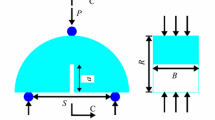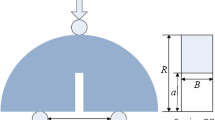Abstract
The weathering-induced changes contribute significant alteration to mechanical and failure characteristics in the rock matrix. It is crucial to evaluate the rock fracture characteristics and mechanical response under different weathering grades because prestressing rock is extremely susceptible to the effects of weathering. Consequently, this study investigates the failure characteristics and numerous generated sandstone fractures at various weathering degrees under quasi-static loadings. Brazilian tests were conducted under different loading rates (LR= 0.001 kN/s, 0.01 kN/s, 0.1 kN/s and 1 kN/s). The findings demonstrated that sandstone tensile strength is equally susceptible to loading rate and weathering grade. The tensile strength of fresh, slightly weathered and moderately weathered sandstone increased by 20%, 54%, and 52%, respectively, with an increase in loading rate from 0.001 to 1 kN/s. The fracture angle (FA), fracture maximum deviation distance (FMDD) and fracture deviation area (FDA) of fresh and moderately weathered sandstone decrease with an increase in loading rate. FMDD of slightly weathered sandstone increases slightly as compared to FA and FDA. Additionally, the results indicate that the fracture length (FL) of slightly and moderately weathered sandstone increases as the loading rate increases, whereas the FL of fresh sandstone decreases as the loading rate increases. Overall, it can be concluded that sandstone strength is affected not only by the loading rate but also by the weathering grade. Based on the laboratory failure characteristics, the geometrical trajectory is divided into single central line fracture, double central line fracture, central-non-central line fracture and non-central line fracture.













Similar content being viewed by others
References
14869-1:2003, I (2003) Geotechnical investigation and testing. Idenification and classification of rock. Part1: Identification and description, 1st edn. International organization for standardization, Geneva, Switzerland
Ahmed Z, Wang S, Hashmi MZ, Zishan Z, Chengjin Z (2020) Causes, characterization, damage models, and constitutive modes for rock damage analysis: a review. Arab J Geosci 13(16):1–14
Akbarimehr D, Hosseini SMMM (2022) Elasto-plastic characteristics of the clay soil mixed with rubber waste using cyclic triaxial test results. Arab J Geosci 15(14):1280
Bageri BS, Benaafi M, Mahmoud M, Patil S, Mohamed A, Elkatatny S (2019) Effect of arenite, calcareous, argillaceous, and ferruginous sandstone cuttings on filter cake and drilling fluid properties in horizontal wells. Geofluids 2019
Bažant ZP, Shang-Ping B, Ravindra G (1993) Fracture of rock: effect of loading rate. Eng Fract Mech 45(3):393–398
Bieniawski Z, Hawkes I (1978) Suggested methods for determining tensile strength of rock materials. Int J Rock Mech Min Sci Geomech Abstr 15(3):99–103
BS 5930 (1981) Code of practice for ground investigations; British Standards Institution (BSI): London, UK, 2015
BSI (2004) BS EN ISO 14689-1: 2003 Geotechnical investigation and testing. In: Identification and classification of rock. Identification and description. BSI Milton Keynes, UK
BSI (2010) BS 5930: 1999+ A2: 2010: code of practice for site investigations. British Standards Institution London
Carvalho TRR, M. F. L., Marques EAG (2020) Influence of weathering and correlations between wave propagation velocity and durability with physical and mechanical parameters in phyllites. Soils Rocks 43(2):297–230
Dai F, Xu Y, Zhao T, Xu N-W, Liu Y (2016) Loading-rate-dependent progressive fracturing of cracked chevron-notched Brazilian disc specimens in split Hopkinson pressure bar tests. Int J Rock Mech Min Sci 88:49–60
Efimov VP (2020) Experimental study on loading rate effects on the tensile strength and fracture toughness of rocks. Geotech Geol Eng 38(6):6923–6930
Eslami A, Akbarimehr D (2021) Failure analysis of clay soil-rubber waste mixture as a sustainable construction material. Constr Build Mater 310:125274
Feng G, Kang Y, Wang X, Hu Y, Li X (2020) Investigation on the failure characteristics and fracture classification of shale under Brazilian test conditions. Rock Mech Rock Eng 53:1–16
Gholami R, Rasouli V (2014) Mechanical and elastic properties of transversely isotropic slate. Rock Mech Rock Eng 47(5):1763–1773
Gong F, Zhang L, Wang S (2019) Loading rate effect of rock material with the direct tensile and three Brazilian disc tests. Adv Civil Eng 2019
Gong F-Q, Zhao G-F (2014) Dynamic indirect tensile strength of sandstone under different loading rates. Rock Mech Rock Eng 47(6):2271–2278
Hack R, Price D (1997) Quantification of weathering Proceedings engineering geology and the environment, Athens, pp 145–150
Han D, Zhu J, Leung Y-F (2020) Deformation of healed rock joints under tension: experimental study and empirical model. Rock Mech Rock Eng 53:1–10
Hashiba K, Fukui K (2015) Index of loading-rate dependency of rock strength. Rock Mech Rock Eng 48(2):859–865
He Q, Liu Z, Li Y, Li D (2021) Laboratory investigation on microcrack fracturing behaviour of granite under quasi-static combined compression and shear. Geomech Geophysics Geo-Energy Geo-Resour 7(3):1–22
Heidari M, Momeni A, Naseri F (2013) New weathering classifications for granitic rocks based on geomechanical parameters. Eng Geol 166:65–73
Hou P, Gao F, Yang Y, Zhang Z, Zhang X (2016) Effect of layer orientation on the failure of block shale under Brazilian splitting test and energy analysis Chin J. Geotech Eng 38(5):930–937
Huang B, Liu J (2013) The effect of loading rate on the behavior of samples composed of coal and rock. Int J Rock Mech Mining Sci 61:23–30
Huang D, Liu Y, Yang Y, Li Z, Meng Q (2021) Experimental study on three-point-bending characteristics of hard and soft rock-like materials under different loading rates. Arab J Geosci 14(18):1–12
ISRM (1981) Rock characterization, testing and monitoring, Pergamon Press, Oxford, p 211
Jaques DS, Marques EAG, Marcellino LC, Leão MF, Ferreira EPS, dos Santos Lemos CC (2020) Changes in the physical, mineralogical and geomechanical properties of a granitic rock from weathering zones in a tropical climate. Rock Mech Rock Eng 53(12):5345–5370
Jin Y, Yuan J, Chen M, Chen K, Lu Y, Wang H (2011) Determination of rock fracture toughness K IIC and its relationship with tensile strength. Rock Mech Rock Eng 44(5):621
Li Y, Li J (2015) Relationship between fracture area and tensile strength of cement paste with supplementary cementitious materials. Constr Build Mater 79:223–228
Liang H, Yuan W, Fu Y, Liu X, Xie Y (2021) Degradation law of mixed-mode (I/II) fracture toughness of sandstone under drying-wetting cycles in acid and alkaline environments. Arab J Geosci 14(14):1–9
Mamonov A, Aslanidis P, Fazilani N, Puntervold T, Strand S (2022) Influence of sandstone mineralogy on the adsorption of polar crude oil components and its effect on wettability. Energy Fuel 36(18):10785–10793
Mhamdi HS, Raji M, Maimouni S, Oukassou M (2017) Fractures network mapping using remote sensing in the Paleozoic massif of Tichka (Western High Atlas, Morocco). Arab J Geosci 10(5):125
Mogi K (1967) Effect of the intermediate principal stress on rock failure. J Geophys Res 72(20):5117–5131
Mujah D, Shahin MA, Cheng L, Karrech A (2021) Experimental and analytical study on geomechanical behavior of biocemented sand. Int J Geomech 21(8):04021126
Pan P-Z, Feng X-T, Hudson J (2012) The influence of the intermediate principal stress on rock failure behaviour: a numerical study. Eng Geol 124:109–118
Peng H, Feng G, Yu-gui Y, Zhi-zhen Z, Ya-nan G, Xiang-xiang Z, Ji Z (2016) Effect of bedding plane direction on acoustic emission characteristics of shale in Brazilian tests. Rock Soil Mech 37(6):1603–1612
Shah KS, Hashim MHBM, Emad MZ, Ariffin KSB, Junaid M, Khan NM (2020) Effect of particle morphology on mechanical behavior of rock mass. Arab J Geosci 13(15):1–17
Shah KS, Mohd Hashim M, Rehman H, Ariffin K (2021) Application of stochastic simulation in assessing effect of particle morphology on fracture characteristics of sandstone. J Mining Environ 12(4):969–986
Shah KS, Mohd Hashim MHB, Rehman H, Ariffin KSB (2022) Weathering induced Brazilian Tensile Strength and fracture characteristics of sandstone and their prevailing mutual association. Int J Mining Geo-Eng 56(2):191–197
Shen H, Li X, Li Q, Wang H (2020) A method to model the effect of pre-existing cracks on P-wave velocity in rocks Journal of Rock Mechanics and Geotechnical. Engineering 12(3):493–506
Soltani A, Taheri A, Deng A, O’Kelly BC (2022) Stabilization of a highly expansive soil using waste-tire-derived aggregates and lime treatment. Case Stud Constr Mater 16:e01133
Su H, Jing H, Du M, Wang C (2016) Experimental investigation on tensile strength and its loading rate effect of sandstone after high temperature treatment. Arab J Geosci 9(13):1–11
Sultan Shah K, Mohd Hashim MHB, Rehman HU, Ariffin KSB (2022) Evaluating microscale failure response of various weathering grade sandstones based on micro-scale observation and micro-structural modelling subjected to wet and dry cycles. J Mining Environ 13(2):341–355
Tang C, Tham L, Lee P, Yang T, Li L (2002) Coupled analysis of flow, stress and damage (FSD) in rock failure. Int J Rock Mech Min Sci 39(4):477–489
Tang Q, Gratchev I (2023) Estimation of sedimentary rock porosity using a digital image analysis. Appl Sci 13(4):2066
Tating F, Hack R, Jetten V (2015) Weathering effects on discontinuity properties in sandstone in a tropical environment: case study at Kota Kinabalu. Sabah Malaysia Bull Eng Geol Environ 74(2):427–441
Tavallali A, Vervoort A (2010) Failure of layered sandstone under Brazilian test conditions: effect of micro-scale parameters on macro-scale behaviour. Rock Mech Rock Eng 43:641–653
Vervoort A, Min K-B, Konietzky H, Cho J-W, Debecker B, Dinh Q-D, Frühwirt T, Tavallali A (2014) Failure of transversely isotropic rock under Brazilian test conditions. Int J Rock Mech Min Sci 70:343–352
Xiong L, Chen H (2020) Effects of high temperatures and loading rates on the splitting tensile strength of jointed rock mass. Geotech Geol Eng 38(2):1885–1898
Yang J, Zhao K, Song Y, Yan Y, He Z, Zhou Y, Gu S (2022) Acoustic emission characteristics and fractal evolution of rock splitting and failure processes under different loading rates. Arab J Geosci 15(3):1–14
Yin Q, Wu J, Zhu C, He M, Meng Q, Jing H (2021) Shear mechanical responses of sandstone exposed to high temperature under constant normal stiffness boundary conditions. Geomech Geophysics Geo-Energy Geo-Resour 7(2):1–17
Zhang K, Zhang C, Qiu S, Gamage PG (2019) Effect of loading rates and stress paths on rock strengths: a novel approach based on experimental evidence. Arab J Geosci 12(7):1–8
Zhang QB, Zhao J (2013) Effect of loading rate on fracture toughness and failure micromechanisms in marble. Eng Fract Mech 102:288–309
Zhang Z, Kou S, Jiang L, Lindqvist P-A (2000) Effects of loading rate on rock fracture: fracture characteristics and energy partitioning. Int J Rock Mech Min Sci 37(5):745–762
Zhang Z, Kou S, Yu J-H, Yu Y, Jiang L, Lindqvist P-A (1999) Effects of loading rate on rock fracture. Int J Rock Mech Min Sci 36(5):597–611
Zhao Z, Jing H, Shi X, Gao Y (2020) Experimental and numerical research on fracture behaviors of sandstone under different loading rates. Geomech Geophysics Geo-Energy Geo-Resour 6(4):1–17
Zhao Z, Wu B, Zhang Z, Yu W (2021) Impact strength characteristics of granite under combined dynamic and static loading conditions. Arab J Geosci 14(2):1–7
Zhi-peng Y, Bai H, Ling-zhi X, Cun-bao L, Jun W (2015) Strength and failure modes of shale based on Brazilian test. Rock Soil Mech 36(12):3447
Zhou L, Zhu Z, Qiu H, Zhang X, Lang L (2018) Study of the effect of loading rates on crack propagation velocity and rock fracture toughness using cracked tunnel specimens. Int J Rock Mech Min Sci 112:25–34
Zhou X-P, Qian Q-H, Yang H-Q (2010) Effect of loading rate on fracture characteristics of rock. J Central South Univ Technol 17(1):150–155
Acknowledgements
Kausar Sultan Shah is extremely thankful to the Higher Education Commission (HEC) of Pakistan for HRDI-UESTPs scholarship. The authors also gratitude to Balochistan University of Information Technology, Engineering and Management Sciences (BUITEMS) for granting an opportunity to conduct experiments in the laboratory facility of the Department of Mining Engineering.
Author information
Authors and Affiliations
Corresponding author
Ethics declarations
Conflict of interest
The authors declare no competing interests.
Additional information
Responsible Editor: Zeynal Abiddin Erguler
Rights and permissions
Springer Nature or its licensor (e.g. a society or other partner) holds exclusive rights to this article under a publishing agreement with the author(s) or other rightsholder(s); author self-archiving of the accepted manuscript version of this article is solely governed by the terms of such publishing agreement and applicable law.
About this article
Cite this article
Shah, K.S., Hashim, M.H.b.M., Rehman, H. et al. Loading rate-induced failure characteristics and fracture classification of various weathering grade sandstone. Arab J Geosci 16, 384 (2023). https://doi.org/10.1007/s12517-023-11473-3
Received:
Accepted:
Published:
DOI: https://doi.org/10.1007/s12517-023-11473-3




